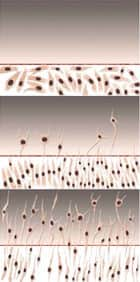Life Extension Magazine®
| by Terri Mitchell
What caused the sci-fi transformation? Vitamin B5, also known as pantothenic acid. Published data shows that B5 speeds wound healing and increases protein synthesis, but this was an amazing performance on the part of individual cells. The group was able to capture the phenomenon on film, and it was published this year in the International Journal of Vitamin and Nutrition Research.  Plate 1 Plate 1Untreated Cells Plate 2 Cells treated with vitamin B5 become elongated and point towards wound Plate 3 B5 treated cells zooming across petri dish towards wound. International Journal for Vitamin and Nutrtion Research, Vol. 69, No. 2, March 1999 Wound repair is a more important issue than most people realize. Any serious accident or sudden need for surgery can thrust a person into a life-or-death struggle to fight off infection and heal. Elective surgery is another situation where wound healing is extremely important. Eye surgery is a common example of a situation where healing is of paramount importance. Plastic surgery is a growing 20 billion-dollar-a-year industry, with laser surgery being one of the most often requested procedures. All of this burning and cutting creates a demand for tissue that heals quickly and smoothly. Getting results Data shows that wound repair involves specific vitamins and minerals. Vitamins B5 and C, copper, zinc, magnesium and manganese are the principle agents involved in repairing damaged tissue. According to experiments done in France, vitamins may actually control the minerals in wound repair. For example, iron is detrimental to wound healing, and vitamins B5 and C decrease iron levels at the wound site. Copper, magnesium and manganese enhance wound repair. Vitamins B5 and C increase these minerals. Vitamin B5 itself has certain actions in wound healing. As the scientists who saw the racing cells observed, B5 greatly speeds repair, increases the number of repair cells, and increases the distance they can travel. B5-related events in wound repair are early events. Later, vitamin C steps in and, along with copper, works to create strong collagen. Copper is very important in wound repair, as it creates cross-links in collagen and elastin that give the proteins strength. Remember, collagen and elastin are parts of the elements that give the body structure, such as bone, tendon and skin. Without these proteins, the human body would disintegrate into a puddle. Copper deficiency in animals causes fragile bones and heart enlargement. Copper supplements have been shown to enhance bone healing. People who get serious burns have depleted copper, and it has been suggested that copper be given as soon after a major burn as possible. Zinc has also been suggested, but this is controversial since zinc and copper antagonize each other. Free Radicals Copper is also critical for the synthesis of a natural antioxidant in the body known as copper/zinc superoxide dismutase (SOD). SOD is extremely important in wound healing. In the early stages of an injury, immune cells rush to the site to fight off invaders. The weapons they use are free radicals. They use them to fight invaders, as well as to vaporize dead tissue. The radicals, however, must be neutralized eventually. This is where SOD and other antioxidants come in. They stop the free radical reactions created by immune cells, so that healing can begin. Depletions of up to 70% in SOD and other antioxidants such as vitamins C and E have been reported after an injury. A person going into a crisis situation with low antioxidant status to begin with is going to have a hard time stopping those reactions and healing properly. Not only do the antioxidants stop the free radical reactions, they promote the repair process. SOD encourages new tissue to grow. It enhances collagen and reduces swelling. Wounds treated with SOD heal better, stronger, quicker. The effect of supplementation A group in France has studied the effect of giving supplemental vitamin B5 and C before tattoo removal. A week before surgery, participants in the study were given 200 milligrams of B5 and 1 gram of vitamin C. Two-and-a-half months after surgery, measurements were taken as to the strength of the scar, the thickness, color and rigidity. The scars of people who had taken the supplements were stronger and thicker, with more color. The vitamins appeared to make better scars by recruiting more minerals to the area. Vitamin C kept iron away, which helped the healing process. The same group has also shown that vitamins B5 and C strengthen wounds made during colon surgery. A lot of research has been conducted on the effects of vitamins on wound repair at the cellular level. But very few studies have been done on living, breathing humans. This is unfortunate, since wound repair is an important and ubiquitous occurrence. There are many potential benefits of understanding optimal tissue regeneration. Days might be shaved off of post-surgical hospital stays if supplemental vitamin B5 and C were given beforehand. Copper and SOD might enhance the outcome in plastic and laser surgery. And bone loss might be averted by studying the effects of copper and B5. There might be potential benefits for aging skin if we understood optimal healing. For now, however, we can be aware that a common, readily-available vitamin is jet fuel for skin cells. References
|
